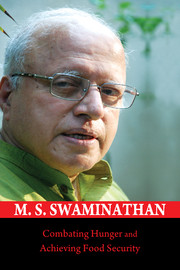Book contents
- Frontmatter
- Contents
- Foreword
- Preface
- Acknowledgements
- Abbreviations
- 1 Genesis and Growth of the Yield Revolution in Wheat
- 2 Our Agricultural Heritage
- 3 Shaping Our Agricultural Destiny
- 4 Thrust on Farm Revival
- 5 Nutri-farm Movement
- 6 Nutrition-sensitive Agriculture
- 7 Food Losses and Food Waste
- 8 Rice in Zero Hunger Challenge
- 9 Monsoon Management
- 10 Importance of Ecological Conservation
- 11 Caring for Ecology and Heritage
- 12 Conserving Biodiversity
- 13 Overcoming Hidden Hunger through Aquaculture
- 14 Biofuels – The Way to Go
- 15 Food Security
- 16 Vigilance for Sustainable Food Security
- 17 Food Security and Social Protection
- 18 Food Security and its Role
- 19 Sustaining the Livestock Revolution
- 20 Challenges in the Year of Science
- 21 Agriculture and Humanism
- 22 Fostering the Science of Science Communication
- 23 Olympic Move for Saving Children
- 24 Youth: The Agents of Change
- 25 Role of Women in Agricultural Production
- 26 Know-how to Do-how
- 27 From Bengal Famine to Right to Food
- 28 Financial Institutions and Fighting Food Inflation
- 29 Public Good Research in Agriculture
- 30 The Future of Indian Agriculture
- Bibliography
2 - Our Agricultural Heritage
Published online by Cambridge University Press: 18 December 2015
- Frontmatter
- Contents
- Foreword
- Preface
- Acknowledgements
- Abbreviations
- 1 Genesis and Growth of the Yield Revolution in Wheat
- 2 Our Agricultural Heritage
- 3 Shaping Our Agricultural Destiny
- 4 Thrust on Farm Revival
- 5 Nutri-farm Movement
- 6 Nutrition-sensitive Agriculture
- 7 Food Losses and Food Waste
- 8 Rice in Zero Hunger Challenge
- 9 Monsoon Management
- 10 Importance of Ecological Conservation
- 11 Caring for Ecology and Heritage
- 12 Conserving Biodiversity
- 13 Overcoming Hidden Hunger through Aquaculture
- 14 Biofuels – The Way to Go
- 15 Food Security
- 16 Vigilance for Sustainable Food Security
- 17 Food Security and Social Protection
- 18 Food Security and its Role
- 19 Sustaining the Livestock Revolution
- 20 Challenges in the Year of Science
- 21 Agriculture and Humanism
- 22 Fostering the Science of Science Communication
- 23 Olympic Move for Saving Children
- 24 Youth: The Agents of Change
- 25 Role of Women in Agricultural Production
- 26 Know-how to Do-how
- 27 From Bengal Famine to Right to Food
- 28 Financial Institutions and Fighting Food Inflation
- 29 Public Good Research in Agriculture
- 30 The Future of Indian Agriculture
- Bibliography
Summary
In all areas of human endeavour, the past, present and future constitute a continuum. The past history of biodiversity conservation teaches many lessons. First of all, about 10,000 years ago, men went out hunting for food, women started gathering seeds and cultivating crops. This was the origin of agriculture or settled cultivation. The evolution of agriculture was based on selection from naturally-occurring genetic variability. Thus, there is a strong relationship between cultural, culinary and curative diversity and agro-biodiversity.
The 2009 bicentenary celebration of Charles Darwin's life and work reminded us that the great biodiversity on Earth underlies natural selection, selective breeding, and the biotechnology required to provide humanity with food, fibre, fodder and fuels. In particular, biodiversity affords the development of plant varieties with novel genetic combinations, which will be required to meet the challenges arising from adverse alterations in temperature, precipitation, sea level, and the frequency of drought and floods – all of which are anticipated from human-induced climate change. The loss of each gene and species, therefore, limits the options for the future.
It has been an act of foresight on the part of the Food and Agriculture Organization (FAO) of UN, to initiate a programme for recognizing globally important agricultural heritage systems (GIAHS). These have been defined by FAO as: ‘remarkable land-use systems and landscapes which are rich in globally significant biological diversity evolving from the co-adaptation of a community with its environment and its needs and aspirations for sustainable development.’
The selection of GIAHS sites is done by a high level panel of scientists headed by Professor Li Wenhua of China. The Satoyama and Satoumi area of the Noto peninsula of Japan is the first GIAHS-recognized site. The Satoyama-Satoumi system is a beautiful example of ‘agri-culture’, which creates wisdom and life in a sustainable environment and passes on blessings and happiness from present to future generations. So far, 19 agricultural heritage systems have been recognized in 14 countries. In India, two systems, namely, the tribal agro-biodiversity-based sustainable agricultural system of Koraput in Odisha and the Kuttanad below sea level farming system of Kerala have been denoted as globally important agricultural heritage systems.
These two GIAHS sites serve as inspiring examples of human innovation and creativity in the field of agriculture and food security.
- Type
- Chapter
- Information
- Combating Hunger and Achieving Food Security , pp. 11 - 14Publisher: Cambridge University PressPrint publication year: 2016



